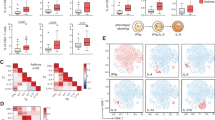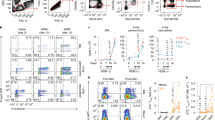Abstract
Studies in both humans and rodents indicate that CD8+ T cells may be important in allergic inflammation. However, neither the mechanisms that mediate CD8+ T cell recruitment to inflamed tissues nor the relative participation of effector and central memory CD8+ T cells is known. Here we report that activated mast cells induced chemotaxis of effector, but not central memory, CD8+ T cells through production of leukotriene B4 (LTB4). These studies indicate that LTB4 production by activated peripheral leukocytes could be important for the recruitment of effector CD8+ T cells to sites of inflammation.
This is a preview of subscription content, access via your institution
Access options
Subscribe to this journal
Receive 12 print issues and online access
$209.00 per year
only $17.42 per issue
Buy this article
- Purchase on Springer Link
- Instant access to full article PDF
Prices may be subject to local taxes which are calculated during checkout







Similar content being viewed by others
Accession codes
References
Metcalfe, D.D., Baram, D. & Mekori, Y.A. Mast cells. Physiol. Rev. 77, 1033–1079 (1997).
Benoist, C. & Mathis, D. Mast cells in autoimmune disease. Nature 420, 875–878 (2002).
Mekori, Y.A. & Metcalfe, D.D. Mast cell-T cell interactions. J. Allergy Clin. Immunol. 104, 517–523 (1999).
Gonzalez, M.C. et al. Allergen-induced recruitment of bronchoalveolar helper (OKT4) and suppressor (OKT8) T-cells in asthma. Relative increases in OKT8 cells in single early responders compared with those in late-phase responders. Am. Rev. Respir. Dis. 136, 600–604 (1987).
Haczku, A. et al. T-cells subsets and activation in bronchial mucosa of sensitized Brown-Norway rats after single allergen exposure. Immunology 85, 591–597 (1995).
Hamelmann, E. et al. Requirement for CD8+ T cells in the development of airway hyperresponsiveness in a murine model of airway sensitization. J. Exp. Med. 183, 1719–1729 (1996).
Sallusto, F., Lenig, D., Forster, R., Lipp, M. & Lanzavecchia, A. Two subsets of memory T lymphocytes with distinct homing potentials and effector functions. Nature 401, 708–712 (1999).
Masopust, D., Vezys, V., Marzo, A.L. & Lefrancois, L. Preferential localization of effector memory cells in nonlymphoid tissue. Science 291, 2413–2417 (2001).
Weninger, W., Crowley, M.A., Manjunath, N. & von Andrian, U.H. Migratory properties of naive, effector, and memory CD8+ T cells. J. Exp. Med. 194, 953–966 (2001).
Manjunath, N. et al. Effector differentiation is not prerequisite for generation of memory cytotoxic T lymphocytes. J. Clin. Invest. 108, 871–878 (2001).
Ott, V.L., Tamir, I., Niki, M., Pandolfi, P.P. & Cambier, J.C. Downstream of kinase, p62dok, is a mediator of FcγIIB inhibition of FcεRI signaling. J. Immunol. 168, 4430–4439 (2002).
Teague, T.K. et al. Activation changes the spectrum but not the diversity of genes expressed by T cells. Proc. Natl. Acad. Sci. USA 96, 12691–12696 (1999).
Yokomizo, T., Izumi, T. & Shimizu, T. Leukotriene B4: metabolism and signal transduction. Arch. Biochem. Biophys. 385, 231–241 (2001).
Dixon, R.A. et al. Requirement of a 5-lipoxygenase-activating protein for leukotriene synthesis. Nature 343, 282–284 (1990).
Tager, A.M. et al. BLTR mediates leukotriene B4-induced chemotaxis and adhesion and plays a dominant role in eosinophil accumulation in a murine model of peritonitis. J. Exp. Med. 192, 439–446 (2000).
Mackarel, A.J., Russell, K.J., Brady, C.S., FitzGerald, M.X. & O'Connor, C.M. Interleukin-8 and leukotriene-B4, but not formylmethionyl leucylphenylalanine, stimulate CD18-independent migration of neutrophils across human pulmonary endothelial cells in vitro. Am. J. Respir. Cell. Mol. Biol. 23, 154–161 (2000).
Yokomizo, T., Kato, K., Terawaki, K., Izumi, T. & Shimizu, T. A second leukotriene B4 receptor, BLT2. A new therapeutic target in inflammation and immunological disorders. J. Exp. Med. 192, 421–432 (2000).
Koch, K. et al. (+)-1-(3S,4R)-[3-(4-phenylbenzyl)-4-hydroxychroman-7-yl]cyclopentane carboxylic acid, a highly potent, selective leukotriene B4 antagonist with oral activity in the murine collagen-induced arthritis model. J. Med. Chem. 37, 3197–3199 (1994).
Showell, H.J., Breslow, R., Conklyn, M.J., Hingorani, G.P. & Koch, K. Characterization of the pharmacological profile of the potent LTB4 antagonist CP-105,696 on murine LTB4 receptors in vitro. Br. J. Pharmacol. 117, 1127–1132 (1996).
Yokomizo, T., Kato, K., Hagiya, H., Izumi, T. & Shimizu, T. Hydroxyeicosanoids bind to and activate the low affinity leukotriene B4 receptor, BLT2. J. Biol. Chem. 276, 12454–12459 (2001).
Yokomizo, T. et al. Leukotriene B4 receptor. Cloning and intracellular signaling. Am. J. Respir. Crit. Care Med. 161, S51–55 (2000).
Yokomizo, T., Izumi, T., Chang, K., Takuwa, Y. & Shimizu, T. A G-protein-coupled receptor for leukotriene B4 that mediates chemotaxis. Nature 387, 620–624 (1997).
Wherry, E.J. et al. Lineage relationship and protective immunity of memory CD8 T cell subsets. Nat. Immunol. 4, 225–234 (2003).
Freeland, H.S., Schleimer, R.P., Schulman, E.S., Lichtenstein, L.M. & Peters, S.P. Generation of leukotriene B4 by human lung fragments and purified human lung mast cells. Am. Rev. Respir. Dis. 138, 389–394 (1988).
Katz, H.R. et al. Secretory granule mediator release and generation of oxidative metabolites of arachidonic acid via Fc-IgG receptor bridging in mouse mast cells. J. Immunol. 148, 868–871 (1992).
Sayama, K. et al. Transcriptional response of human mast cells stimulated via the FcεRI and identification of mast cells as a source of IL-11. BMC Immunol. 3, 5 (2002).
Nakajima, T. et al. Marked increase in CC chemokine gene expression in both human and mouse mast cell transcriptomes following Fcε receptor I cross-linking: an interspecies comparison. Blood 100, 3861–3868 (2002).
Aoki, M., Pawankar, R., Niimi, Y. & Kawana, S. Mast cells in basal cell carcinoma express VEGF, IL-8 and RANTES. Int. Arch. Allergy Immunol. 130, 216–223 (2003).
Kimura, Y., Pawankar, R., Aoki, M., Niimi, Y. & Kawana, S. Mast cells and T cells in Kimura's disease express increased levels of interleukin-4, interleukin-5, eotaxin and RANTES. Clin. Exp. Allergy 32, 1787–1793 (2002).
Leppert, D. et al. Stimulation of matrix metalloproteinase-dependent migration of T cells by eicosanoids. Faseb J. 9, 1473–1481 (1995).
Morita, H., Takeda, K., Yagita, H. & Okumura, K. Immunosuppressive effect of leukotriene B4 receptor antagonist in vitro. Biochem. Biophys. Res. Commun. 264, 321–326 (1999).
Gualde, N., Atluru, D. & Goodwin, J.S. Effect of lipoxygenase metabolites of arachidonic acid on proliferation of human T cells and T cell subsets. J. Immunol. 134, 1125–1129 (1985).
Payan, D.G., Missirian-Bastian, A. & Goetzl, E.J. Human T-lymphocyte subset specificity of the regulatory effects of leukotriene B4. Proc. Natl. Acad. Sci. USA 81, 3501–3505 (1984).
Bailie, M.B. et al. Leukotriene-deficient mice manifest enhanced lethality from Klebsiella pneumonia in association with decreased alveolar macrophage phagocytic and bactericidal activities. J. Immunol. 157, 5221–5224 (1996).
Griffiths, R.J. et al. Collagen-induced arthritis is reduced in 5-lipoxygenase-activating protein-deficient mice. J. Exp. Med. 185, 1123–1129 (1997).
Turner, C.R. et al. In vitro and in vivo effects of leukotriene B4 antagonism in a primate model of asthma. J. Clin. Invest. 97, 381–387 (1996).
Henderson, W.R., Jr. et al. The importance of leukotrienes in airway inflammation in a mouse model of asthma. J. Exp. Med. 184, 1483–1494 (1996).
Malaviya, R. & Abraham, S.N. Role of mast cell leukotrienes in neutrophil recruitment and bacterial clearance in infectious peritonitis. J. Leukoc. Biol. 67, 841–846 (2000).
Ramos, B.F., Zhang, Y., Qureshi, R. & Jakschik, B.A. Mast cells are critical for the production of leukotrienes responsible for neutrophil recruitment in immune complex-induced peritonitis in mice. J. Immunol. 147, 1636–1641 (1991).
Iwamoto, I., Tomoe, S., Tomioka, H. & Yoshida, S. Leukotriene B4 mediates substance P-induced granulocyte infiltration into mouse skin. Comparison with antigen-induced granulocyte infiltration. J. Immunol. 151, 2116–2123 (1993).
Lefrancois, L. & Masopust, D. T cell immunity in lymphoid and non-lymphoid tissues. Curr. Opin. Immunol. 14, 503–508 (2002).
Swanson, B.J., Murakami, M., Mitchell, T.C., Kappler, J. & Marrack, P. RANTES production by memory phenotype T cells is controlled by a posttranscriptional, TCR-dependent process. Immunity 17, 605–615 (2002).
Oshiba, A. et al. Passive transfer of immediate hypersensitivity and airway hyperresponsiveness by allergen-specific immunoglobulin (Ig) E and IgG1 in mice. J. Clin. Invest. 97, 1398–1408 (1996).
Acknowledgements
The authors thank R.C. Murphy for contributions to this work, and B. Townend, S. Sobus and J. Loomis for technical assistance with cell sorting. This work was supported by US Public Health Service grants AI-17134, AI-18785, AI-52225 and AI-22295 (to P.M. and J.K.), and AI-39773 (to J.C.C.). V.L.O. is supported by a National Research Service Award from the National Institutes of Health. B.J.S. is supported by a Norman B. Levy Fellowship in Basic Immunological Research from National Jewish Medical and Research Center.
Author information
Authors and Affiliations
Corresponding author
Ethics declarations
Competing interests
The authors declare no competing financial interests.
Rights and permissions
About this article
Cite this article
Ott, V., Cambier, J., Kappler, J. et al. Mast cell–dependent migration of effector CD8+ T cells through production of leukotriene B4. Nat Immunol 4, 974–981 (2003). https://doi.org/10.1038/ni971
Received:
Accepted:
Published:
Issue Date:
DOI: https://doi.org/10.1038/ni971
This article is cited by
-
Exploiting innate immunity for cancer immunotherapy
Molecular Cancer (2023)
-
BLT1 mediates commensal bacteria-dependent innate immune signals to enhance antigen-specific intestinal IgA responses
Mucosal Immunology (2019)
-
Cancer-associated secondary lymphoedema
Nature Reviews Disease Primers (2019)
-
Tumor-infiltrating mast cells predict prognosis and gemcitabine-based adjuvant chemotherapeutic benefit in biliary tract cancer patients
BMC Cancer (2018)
-
Role of Mast Cells in Regulation of T Cell Responses in Experimental and Clinical Settings
Clinical Reviews in Allergy & Immunology (2018)



